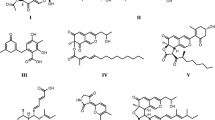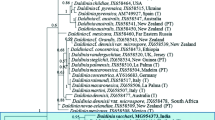Abstract
Several species of the genus Hypoxylon (Xylariaceae) were studied for morphological characters and HPLC-based secondary metabolite profiles. It was confirmed that Hypoxylon is divided into two groups of species, containing either Mitorubrin type azaphilones or binaphthyls, respectively, as main metabolites. In Hypoxylon species of the latter group, some metabolites that are known from the allied genus Daldinia (i.e., Daldinal A in H. fuscum and Daldinin C in H. fuscopurpureum), were encountered for the first time. Moreover, three novel aromatic polyketides, for which the trivial names Macrocarpones A, B and C are proposed, were isolated from ascostromata of Hypoxylon macrocarpum and identified by high resolution mass spectrometry and 2D-NMR spectroscopy. Orsellinic Acid was also identified from ascostromata of H. howeianum and detected by HPLC-MS and HPLC-UV/Vis fingerprinting methodology in H. fragiforme and H. rubiginosum, but not in other examined Hypoxylon species. Due to these studies, H. fuscopurpureum sensu Y.-M. Ju & J.D. Rogers 1996 was identified as a new record for Germany.
Similar content being viewed by others
References
Casser I (1983) Isolierung und Strukturaufklärung von Farbstoffen aus holzbewohnenden Pilzen. Doctoral thesis. Univ. Bonn, Germany. 133 pp
Gill M, Steglich W (1987) Pigments of fungi (Macromycetes). In Herz W, Grisebach H, Kirby GW, Tamm C (eds) Progress in the chemistry of organic natural products. vol. 51. Springer Verlag Berlin, Heidelberg, New York
Granmo A (1999) Morphotaxonomy and chorology of the genus Hypoxylon (Xylariaceae) in Norway. — Sommerfeltia 26: 1–81
Hesse, M, Meier H, Zeeh B (1991) Spektroskopische Methoden in der organischen Chemie, p.186 (Benzylmethylketon)
Igarashi M, Tetsuka Y, Mimura Y, Takahashi A, Tamamura T, Sato K (1993) AB5046A and B, novel chlorosis-inducing substances from Nodulisporium sp. — Journal of Antibiotics 46: 1843–1848
Jayaprakasha, GK, Rao, LJ (2000) Phenolic constituents from the lichen Parmotrema stuppeum (Nyl.)Hale and their antioxidant activity. — Zeitschrift für Naturforschung C (Journal of Biosciences) 55: 1018–1022
Ju YM, Rogers JD (1996) A revision of the genus Hypoxylon. Mycologia Memoir no. 20. APS Press, St. Paul, MN., USA 365 pp
Krieglsteiner GJ, Enderle M (1989) Über Vorkommen, Verbreitung und Ökologie einiger Arten der Gattungen Biscogniauxia O. Kuntze 1891, Nemania S.F. Gray 1821 emend. Pouzar 1986 und Hypoxylon Bulliard 1791 s. str. in der Bundesrepublik Deutschland und einigen Nachbarländern. — Mitteilungsblatt der AG Pilzkunde Niederrhein 7: 46–89
Martin P (1968) Studies in the Xylariaceae: IV. Hypoxylon, sections Papillata and Annulata. — South African Journal of Botany 34: 303–330
Mazzaglia H, Anselmi N, Vicario S, Vannini A (2001) Sequence analysis of the 5.8S rDNA and ITS region in evaluating genetic relationships among some species of Hypoxylon and related genera. — Mycological Research 105: 670–675
Miller JH (1961) A monograph of the world species of Hypoxylon. Univ. Georgia Press, Athens, Georgia, USA
Ogasawara N, Kawai K (1998) Hydrogenated azaphilones from Emericella falconensis and E. fruticulosa. — Phytochemistry 47: 1131–1135
Petrini, LE, Müller E (1986) Haupt-und Nebenfruchtformen europäischer Hypoxylon-Arten (Xylariaceae, Sphaeriales) und verwandter Pilze. — Mycologia Helvetica 1: 501–627
Petrini LE, Petrini O, Sieber TN (1987) Host specificity of Hypoxylon fuscum: A statistical approach to the problem. — Sydowia 40: 227–234
Pouzar Z (1978) Hypoxylon macrocarpum Pouz. spec. nov., a new fragrant Pyrenomycete. — Ceská Mykologia 32: 19–21
Rogers JD, Ju YM (1996) Entoleuca mammata comb. nov. for Hypoxylon mammatum and the genus Entoleuca. — Mycotaxon 59: 441–448
Rayner RW (1970) A mycological colour chart. Commonwealth Mycological Institute, Kew and British Mycological Society.
Rogers JD, Ju YM (1998) The genus Kretzschmaria. — Mycotaxon 68: 345–393
Salvatore MJ, Hensens OD, Zink DL, Liesch J, Dufresne C, Ondeyka J, Jürgens TM, Borris RP, Raghoobar S, McCauley E, Kong L, Gartner SE, Koch G, Pelaéz F, Diez MT, Cascales C, Martin I, Polishook JD, Balick MJ, Beck HT, King SR, Hsu A, Lingham RB (1994) L-741,494, a fungal metabolite that is an inhibitor of interleukin-1β converting enzyme. — Journal of Natural Products 57: 755–760
Sánchez-Ballesteros J, González V, Salazar O, Acero J, Portal MA, Julián, M, Rubio V, Bills GF, Polishook JD, Platas G, Mochales S, Peláez F (2000) Phylogenetic study of Hypoxylon and related genera based on ribosomal ITS sequences. — Mycologia 92: 964–977
Schulz H, Albroscheit G (1989) Characterization of oakmoss products used in perfumery by high-performance liquid chromatography. — Journal of Chromatography 466: 301–306
Stadler M, Baumgartner M, Wollweber H. (2001) Three new Daldinia species with yellow stromatal pigments. — Mycotaxon 80: 179–196
Stadler M, Baumgartner M, Grothe T, Mühlbauer A, Seip S, Wollweber H (2001a) Concentricol, a taxonomically significant triterpenoid from Daldinia concentrica. — Phytochemistry 56: 787–793
Stadler M, Wollweber H, Baumgartner M, Ju YM and Rogers JD (2001b) Daldinia decipiens sp. nov. and notes on further Daldinia spp. inhabiting Betulaceae in Europe. — Mycotaxon 80: 167–176
Stadler M, Wollweber H, Mühlbauer A, Asakawa Y, Hashimoto T, Rogers JD, Ju YM, Wetzstein HG, Tichy HV (2001c) Molecular chemotaxonomy of Daldinia and other Xylariaceae. — Mycological Research 109: 1191–1205
Stadler M, Wollweber H, Mühlbauer A, Henkel T, Wollweber H, Asakawa Y, Hashimoto T, Rogers JD, Ju YM, Wetzstein HG, Tichy HV (2001d) Secondary metabolite profiles, genetic fingerprints and taxonomy of Daldinia and allies. — Mycotaxon 77: 379–429
Suzuki S, Hosoe T, Nozawa K, Yaguchi T, Udagawa S, Kawai K (1999) Mitorubrin derivatives on ascomata of some Talaromyces species of ascomyceteous fungi. — Journal of Natural Products 62: 1329–1329
Turner, R. (1971) Fungal metabolites. Chapter 5. Polyketides. Academic Press London, New York
Whalley AJS, Edwards RL (1995) Secondary metabolites and systematic arrangement within the Xylariaceae. — Canadian Journal of Botany 73Suppl. 1: S802–S810
Wollweber H, Stadler M (2001) Zur Kenntnis der Gattung Daldinia in Deutschland und Europa. — Zeitschrift für Mykologie 67: 3–53
Author information
Authors and Affiliations
Corresponding author
Rights and permissions
About this article
Cite this article
Mühlbauer, A., Triebel, D., Persoh, D. et al. Macrocarpones, novel metabolites from stromata of Hypoxylon macrocarpum, and new evidence on the chemotaxonomy of Hypoxylon species. Mycol Progress 1, 235–248 (2002). https://doi.org/10.1007/s11557-006-0021-z
Accepted:
Issue Date:
DOI: https://doi.org/10.1007/s11557-006-0021-z




